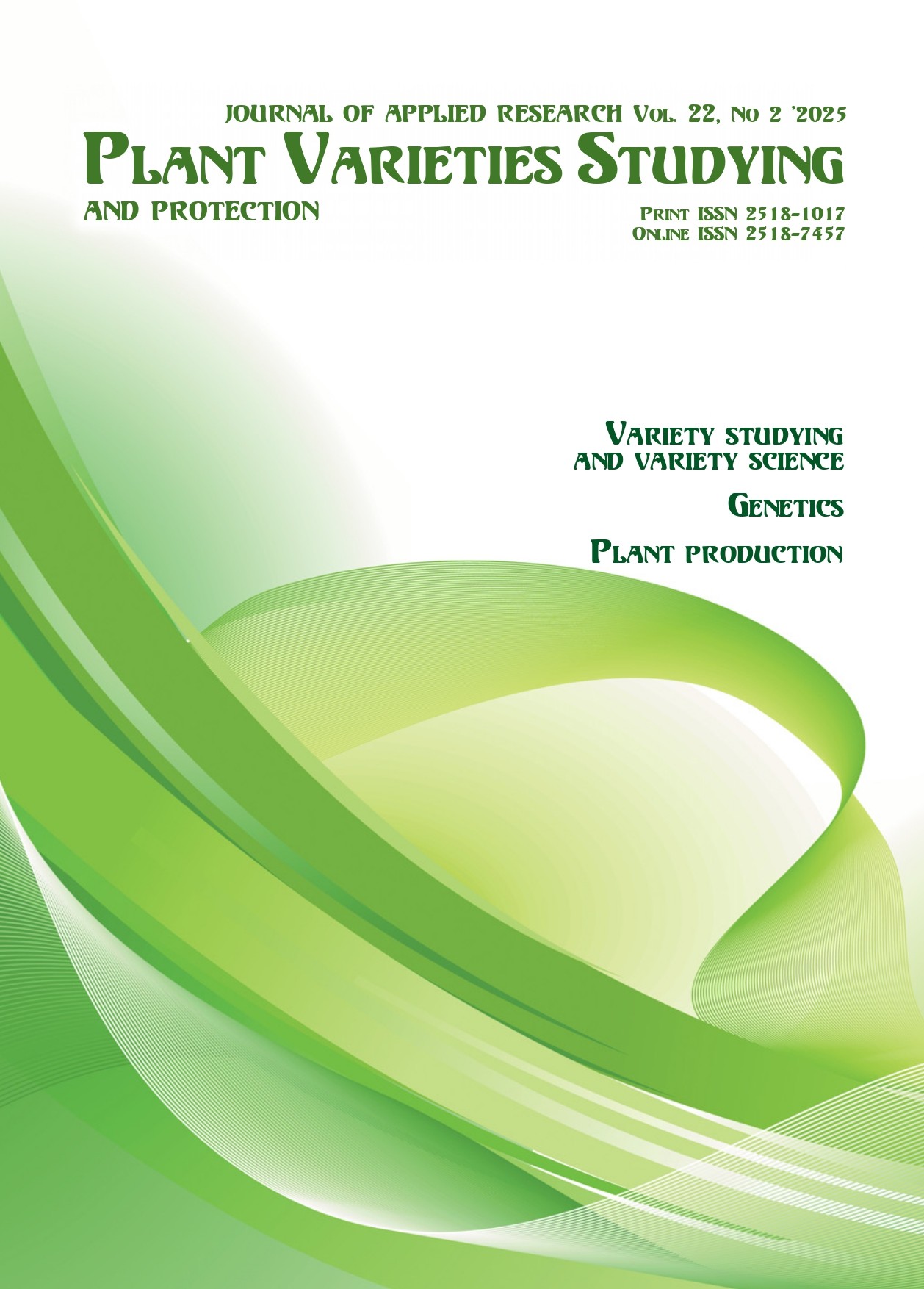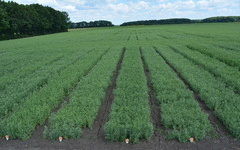Microsatellite analysis of chickpea (Cicer arietinum L.) genotypes
DOI:
https://doi.org/10.21498/2518-1017.21.2.2025.333450Keywords:
chickpea, drought tolerance, polymorphism, microsatellite loci, PCRAbstract
Purpose. To investigate the polymorphism of chickpea genotypes at microsatellite loci within the QTL-hotspot region of linkage group 4, associated with drought tolerance. Methods. DNA extraction and purification from seedlings using the CTAB method; polymerase chain reaction; horizontal gel electrophoresis; determination of amplification product sizes using the “GelAnalyzer” software; cluster analysis using the “MEGA12” software. Results. Of the 26 samples analyzed from the International Crops Research Institute for the Semi-Arid Tropics (ICRISAT) collection, one to eight alleles were identified at the following microsatellite (SSR) loci within the QTL-hotspot region of linkage group 4 in the chickpea genome: ICCM0249, NCPGR127, TAA170, NCPGR21, TA130 and STMS11. The distribution of SSR locus alleles in the samples under study was compared with that in chickpea samples from various breeding centers, including those in Ukraine. Genetic distances were calculated for the 26 ICRISAT samples and seven Ukrainian varieties. A dendrogram was constructed which grouped the samples into seven clusters; the Ukrainian chickpea varieties formed a separate cluster. Conclusions. The chickpea samples from the ICRISAT collection were found to be polymorphic at SSR loci ICCM0249, TAA170, and TAA130, with three, five, and eight alleles respectively, and monomorphic at three SSR loci: STMS11, NCPGR127, and NCPGR21. This distribution of polymorphic and monomorphic alleles corresponded to that observed in the Ukrainian chickpea varieties. Cluster analysis revealed that the Ukrainian varieties formed a distinct group, suggesting differences in genetic origin and breeding approaches compared to the ICRISAT collection.
Downloads
References
Koloianidi, N. O. (2024). Productivity and quality of chickpea under conditions of water deficit. Plant Physiology and Genetics, 56(6), 515–528. https://doi.org/10.15407/frg2024.06.515
Keerthi Sree, Y., Lakra, N., Manorama, K., Ahlawat, Y., Zaid, A., Elansary, H. O., Sayed, S. R. M., Rashwan, M. A., & Mahmoud, E. A. (2023). Drought-Induced Morpho-Physiological, Biochemical, Metabolite Responses and Protein Profiling of Chickpea (Cicer arietinum L.). Agronomy, 13(7), Article 1814. https://doi.org/10.3390/agronomy13071814

Asati, R., Tripathi, M. K., Yadav, R. K., Tripathi, N., Sikarwar, R. S., & Tiwari, P. N. (2024). Investigation of Drought Stress on Chickpea (Cicer arietinum L.) Genotypes Employing Various Physiological Enzymatic and Non-Enzymatic Biochemical Parameters. Plants, 13(19), Article 2746. https://doi.org/10.3390/plants13192746
 |
| 
Li, Y., Ruperao, P., Batley, J., Edwards, D., Khan, T., Colmer, T. D., Pang, J., Siddique, K. H. M., & Sutton, T. (2018). Investigating Drought Tolerance in Chickpea Using Genome-Wide Association Mapping and Genomic Selection Based on Whole-Genome Resequencing Data. Frontiers in Plant Science, 9, Article 190. https://doi.org/10.3389/fpls.2018.00190
 |
| 
Khassanova, G., Oshergina, I., Ten, E., Jatayev, S., Zhanbyrshina, N., Gabdola, A., Gupta, N., Schramm, C., Pupulin, A., Philp-Dutton, L., Anderson, P., Sweetman, C., Jenkins, C., Soole, K., & Shavrukov, Y. (2024). Zinc finger knuckle genes are associated with tolerance to drought and dehydration in chickpea (Cicer arietinum L.). Frontiers in Plant Science, 15, Article 1354413. https://doi.org/10.3389/fpls.2024.1354413

Singh, V., Gupta, K., Singh, S., Jain, M., & Garg, R. (2023). Unravelling the molecular mechanism underlying drought stress response in chickpea via integrated multi-omics analysis. Frontiers in Plant Science, 14, Article 1156606. https://doi.org/10.3389/fpls.2023.1156606
 |
| 
Slishchuk, H. I., Volkova, N. E., Vozhehova, R. A., & Marchenko, T. Y. (2025). Role of heat shock proteins in drought tolerance mechanism in chickpea. Plant Physiology and Genetics, 57(1), 18–26. https://doi.org/10.15407/frg2025.01.018
Slishchuk, H. I., & Volkova, N. E. (2025). Molecular mechanisms of chickpea responses to drought stress (minireview). Biopolymers and Cell, 41(1), 13–22. https://doi.org/10.7124/bc.000b0c

Varshney, R. K., Thudi, M., Nayak, S. N., Gaur, P. M., Kashiwagi, J., Krishnamurthy, L., Jaganathan, D., Koppolu, J., Bohra, A., Tripathi, S., Rathore, A., Jukanti, A. K., Jayalakshmi, V., Vemula, A., Singh, S. J., Yasin, M., Sheshshayee, M. S., & Viswanatha, K. P. (2013). Genetic dissection of drought tolerance in chickpea (Cicer arietinum L.). Theoretical and Applied Genetics, 127(2), 445–462. https://doi.org/10.1007/s00122-013-2230-6
 |
| 
Barmukh, R., Roorkiwal, M., Dixit, G. P., Bajaj, P., Kholova, J., Smith, M. R., Chitikineni, A., Bharadwaj, C., Sreeman, S. M., Rathore, A., Tripathi, S., Yasin, M., Vijayakumar, A. G., Rao Sagurthi, S., Siddique, K. H. M., & Varshney, R. K. (2022). Characterization of ‘QTL-hotspot’ introgression lines reveals physiological mechanisms and candidate genes associated with drought adaptation in chickpea. Journal of Experimental Botany, 73(22), 7255–7272. https://doi.org/10.1093/jxb/erac348
 |
| 
Chahande, R. V., Kulwal, P. L., Mhase, L. B., & Jadhav, A. S. (2021). Validation of the markers linked with drought tolerance related traits for use in MAS programme in chickpea. Journal of Genetics, 100(2), Article 74. https://doi.org/10.1007/s12041-021-01324-z
 |
| 
Singh, D., Pushpavalli, S. N. C. V. L., Vanisri, S., & Kumar, G. A. (2021). Assessment of genetic diversity in chickpea genotypes (Cicer arietinum L.) using agro-morphological and SSR markers. The Pharma Innovation Journal, 10(8), 784–791.
Getahun, T., Tesfaye, K., Fikre, A., Haileslassie, T., Chitikineni, A., Thudi, M., & Varshney, R. K. (2021). Molecular genetic diversity and population structure in Ethiopian chickpea germplasm accessions. Diversity, 13(6), Article 247. https://doi.org/10.3390/d13060247

Akinina, G., & Popov, V. (2014). Genetic structure of collection of chickpea varieties by morphological and molecular markers. Visnyk of the Lviv University. Series Biology, 64, 170–176. [In Ukrainian]
Volkova, N. E., Slishchuk, G. I., Zakharova, O. O., Marchenko, T. Yu., Sichkar, V. I., & Vozhehova, R. A. (2023). Analysis of chickpea (Cicer arietinum L.) genotypes by microsatellite loci of the QTL-hotspotregion associated with drought tolerance. Plant Varieties Studying and Protection, 19(4), 226–231. https://doi.org/10.21498/2518-1017.19.4.2023.291223
Rogers, S., & Bendich, A. (1989). Extraction of DNA from plant tissues. In S. B. Gelvin, R. A. Schilperoort, & D. P. S. Verma (Eds.), Plant Molecular Biology Manual (pp. 73–83). Springer. https://doi.org/10.1007/978-94-009-0951-9_6

GelAnalyzer 23.1.1 (available at www.gelanalyzer.com) by Istvan Lazar Jr., PhD and Istvan Lazar Sr., PhD, CSc.
Saitou, N., & Nei, M. (1987). The neighbor-joining method: A new method for reconstructing phylogenetic trees. Molecular Biology and Evolution, 4(4), 406–425. https://doi.org/10.1093/oxfordjournals.molbev.a040454
 |
| 
Tamura, K., Nei, M., & Kumar, S. (2004). Prospects for inferring very large phylogenies by using the neighbor-joining method. Proceedings of the National Academy of Sciences, 101(30), 11030–11035. https://doi.org/10.1073/pnas.0404206101
 |
| 
Kumar, S., Stecher, G., Suleski, M., Sanderford, M., Sharma, S., & Tamura, K. (2024). MEGA12: Molecular Evolutionary Genetic Analysis Version 12 for Adaptive and Green Computing. Molecular Biology and Evolution, 41(12), Article msae263. https://doi.org/10.1093/molbev/msae263
 |
| 
Downloads
Published
How to Cite
Issue
Section
License
Copyright (c) 2025 N. E. Volkova, H. I. Slishchuk, T. Yu. Marchenko, R. A. Vozhehova

This work is licensed under a Creative Commons Attribution-ShareAlike 4.0 International License.
Starting in 2022, the copyright to the publication remains with the authors
Our journal abides by the CREATIVE COMMONS copyright rights and permissions for open access journals.
Authors, who are published in this journal, agree to the following conditions:
- The authors reserve the right to authorship of the work and pass the first publication right of this work to the journal under the terms of a Creative Commons Attribution License, which allows others to freely distribute the published research with the obligatory reference to the authors of the original work and the first publication of the work in this journal.
- The authors have the right to conclude separate supplement agreements that relate to non-exclusive work distribution in the form in which it has been published by the journal (for example, to upload the work to the online storage of the journal or publish it as part of a monograph), provided that the reference to the first publication of the work in this journal is included.

























 Ukrainian Institute for Plant Varieties Examination
Ukrainian Institute for Plant Varieties Examination  Селекційно-генетичний інститут
Селекційно-генетичний інститут Institute of Plant Physiology and Genetics of the National Academy of Sciences of Ukraine
Institute of Plant Physiology and Genetics of the National Academy of Sciences of Ukraine
 The National Academy of Agrarian Sciences of Ukraine
The National Academy of Agrarian Sciences of Ukraine